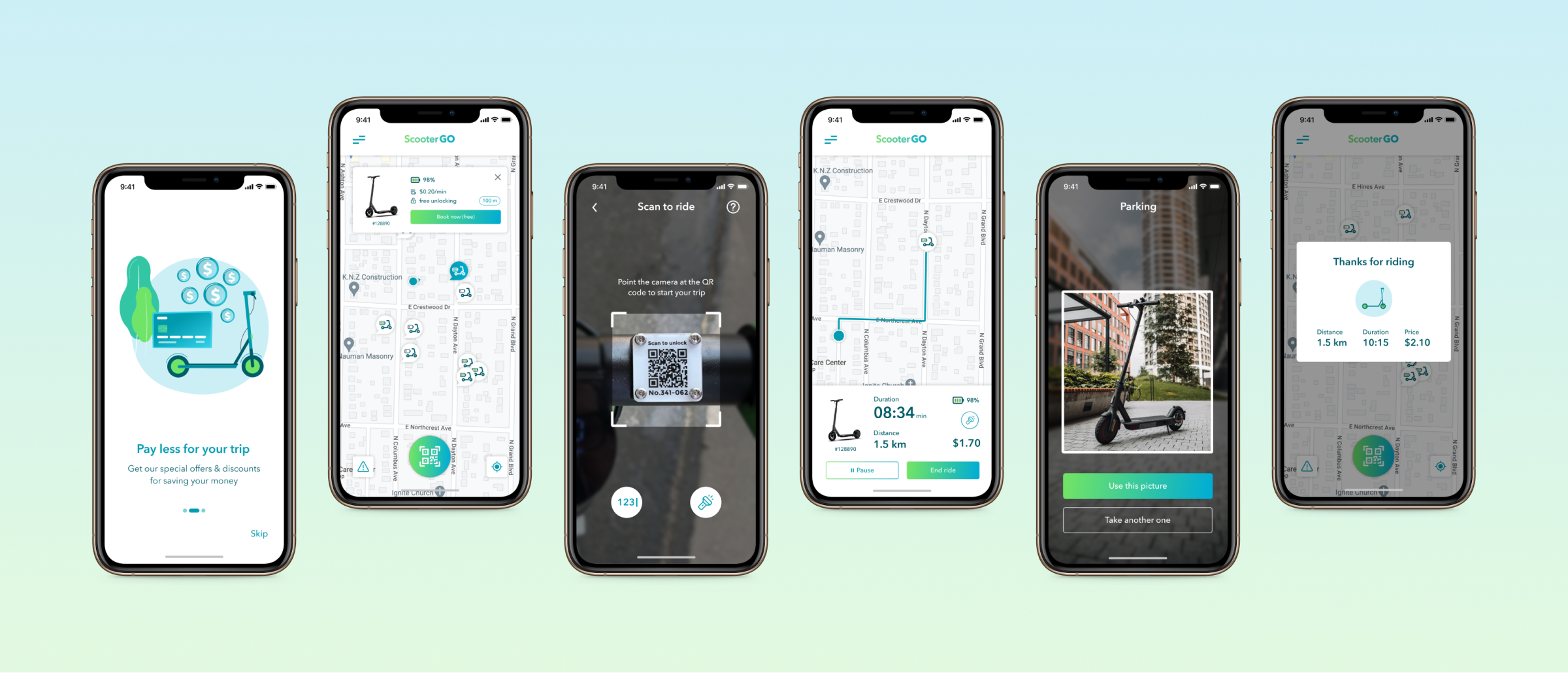White Label Software vs Custom App for Your E-Scooter Sharing Business: Which One to Choose
Choosing between a white-label solution for your scootersharing business and building an app from scratch can be a challenge. Wishing to save both money and time but still launch a viable product, entrepreneurs are torn between these two options. Which road should you follow? We compare both options and provide the estimated cost of each.
The shared mobility industry is thriving. Ridesharing, carsharing, bike-sharing, and scooter sharing companies are popping up like mushrooms after a spring rain. The main driver of their success is environmental concerns. All efforts now are addressed at reducing emissions and traffic congestion. Thanks to this, alternative means of transportation have been able to go big in a short time.
Out of all shared mobility options, scooter sharing appears to be the best option for a startup as it requires a smaller budget than carsharing. Plus, scooters are more fun to ride than bicycles. E-scooters help to solve the first-/last-mile transportation problem.
As Tier investor Elmar Broscheit points out in an interview with Euronews, 20% of ride-hailing (e.g. Uber and Lyft) rides are under 3 kilometers (1.9 miles). This 20% dramatically slows down the other 80%, amplifying congestion and pollution. Cities have been looking for last-mile solutions for a long time. Building bicycle lanes is not a new trend. Electric scooters can serve as an add-on to public transportation, and they produce no emissions.
That being said, let’s go back to the financial part of the matter. The main question is which method of app development to opt for. For starters, let’s take the process of launching an electric scooter sharing startup step by step.
What is an e-scooter sharing system
An e-scooter sharing system is a set of elements that ensure the smooth work of a scooter sharing business. Scooter sharing requires two fundamental components: physical resources/hardware (scooters, on-scooter devices) and software (mobile app, admin panel, and server).
Hardware
Unless you’re planning to start your own production, most likely you’ll buy a fleet of scooters from an existing scooter manufacturer. There are companies specialized in producing scooters solely for rental means. These scooters are more durable and come equipped with high-capacity batteries, IoT controllers, and anti-vandal protection. They’re also white-label, which means you can put your scooter sharing company’s name on them and design them to your liking.
Software
Another essential aspect to consider is software. The system that operates the whole process is based on these elements:
- a user app
- a fleet management platform
- an app for service staff
- API integration
- a server infrastructure
Remember that these systems are all required. Steady and seamless operation is ensured by high connectivity and synchronization between the system’s three parts. This means that each component must show high performance. Frequent app crashes, payment system issues, or scooters failing to unlock will scare away users and investors.
Steady and seamless operation is ensured by high connectivity and synchronization between the three parts of the scootersharing system: a server (backend), admin panel, and mobile app (frontend).
There are two ways to obtain software for your scooter-sharing endeavor. The first is to license an out-of-the-box solution, in which case you won’t have a chance to change anything at later stages.
The second is to build custom e-scooter sharing software tailored to your needs. Both options have their advantages and disadvantages, and it’s up to you which to choose. Let’s look closely at the benefits they offer and the obstacles they bring.
White-label solution for e-scooter sharing software. Pros and Cons
Some scooter manufacturers – often based in China – offer all-inclusive packages: scooters at an attractive price (say $400 each) along with e-scooter sharing software.
China is one of the top scooter manufacturers globally. The electric scooter and motorcycle market in China was worth $7.7 billion in 2017, and is projected to reach $12.5 billion by 2025. Within China, government support for electric scooters is limited, and battery-swapping facilities and recharging stations are only available in a few cities. But the market is growing steadily.
However, Chinese manufacturers mainly focus on the export market, offering a wide range of electric scooters at different price points and specifications. So it doesn’t come as a surprise that many scootersharing startups fill their fleets with scooters from China. For instance, Bird and Spin are using Mi scooters produced by Xiaomi’s subsidiary Ninebot.
Such scootersharing companies as Bird and Spin are using Mi scooters produced by Xiaomi’s subsidiary Ninebot.
Now, let’s talk about pitfalls of choosing a ready solution for your startup. Even though you can get a cost-efficient package in a few months, you won’t be able to use the software you’ve paid for. At the same time, you won’t get a chance to test the software unless you provide a 15% prepayment (around $10–15K) and sign a contract.
In such a way, scooter companies try to protect their data (APIs) from theft, though usually, they use standard protocols suited for every IoT device. Apart from this, you’re obliged to pay a monthly service fee for each scooter in your fleet (about $10–15 per scooter).
Some white-label scooter-sharing companies don’t charge a monthly fee; instead, they charge a share of your revenue.
Let’s sum up the pros and cons of buying white-label scooter sharing software:
- Cheaper
- Convenient
- Fast Time to Market
- Only takes 1–2 months
- You don’t have rights to the software
- You need to pay a monthly service fee
- You can’t alter the code
- You receive a standard design and features
- You can’t test the API before purchasing
- The vendor can see your database and transactions
Scooter sharing franchise. Pros and Cons
You can also partner with a scooter-sharing company that offers franchises as an alternative to purchasing a white-label solution. Franchising is a good way to launch your business fast, as it already has all the tools, a business plan, and constant support.
With a franchise, you only need to invest the initial capital and run the business according to the recommendations of your company, that provides you with legal and customer support, business advice, and more.
However, this all comes with lots of restrictions, a lack of control over your business decisions, and royalties that can be pretty hefty, starting at 9% and higher.
- You get a ready business plan
- You can start very fast
- You get all kinds of support
- You get your scooter fleet from your company
- You’re dependent on your franchisor and their support
- You need to run business under a set of restrictions
- You can’t make your own business decisions
- You have to pay royalties
- You can’t change anything about the given software and hardware
- You need to share your financial information with a franchiser
- The support you get can be poor
Custom e-scooter sharing solution. Pros and Cons
Your other option is to build custom software. The main perk of this option is that you decide on what features to implement and technologies to integrate and can make suggestions during the development process. This way, you can tailor your app to your liking. If you’re building your own app, you’ll pay only for the product and won’t be charged any service fees. And only you will have access to the app’s admin panel.
Integrating third-party services (analytics tools, payment gateways, messengers) and creating a user-friendly UI/UX is possible. You can add/change/delete any feature along the way. Another advantage is that a custom app isn’t limited to one scooter model and can connect with different IoT controllers.
However, when choosing to develop scooter sharing software from scratch, you need to understand that development might take 1.5 to 2 months or more depending on the list of features.
A custom app isn’t limited to one model of scooter and can connect with different IoT controllers.
Let’s list the pros and cons of a custom app:
- All rights to the software belong to you
- You can take out a patent for features and white-label your software
- You can integrate third-party services
- Custom software can support different scooters
- Unique UI/UX
- You can add/change/delete features
- You’ll receive a three-month guarantee on bug fixes*
- The database is yours
- Suited for a long-term endeavour
- No service fees
- Can recoup the cost of development in less than half a year
- You receive only software, which means you still need to buy scooters separately
- Development might take 1.5 to 2 months or more depending on the list of features
- The price of development is higher
- Longer Time to Market
The best of both worlds: ScooterGO from Mobindustry
We at Mobindustry recognized all the disadvantages of a regular white-label solution and decided to eliminate them in our product. ScooterGO is a ready scooter-sharing application that combines the cost-efficiency of a white-label app with a flexibility of a custom solution.
With ScooterGO, you get a full infrastructure for your e-scooter sharing business without any monthly payments, ongoing fees or a percentage of your future revenue. With ScooterGO, you have full control over your code and business data.

Here’s what you get with ScooterGO for just 50% of a custom scooter sharing system budget:
- A customizable customer-facing mobile app
- A fleet management system
- Our full support in app store publishing
- Server infrastructure
- IoT controller integration
- Scooter supplier integration
- Payment system integration
- Maintenance and support
With this package, you get everything you need to quickly launch your MVP and successfully expand and scale it further. But what makes ScooterGO different from other white-label solutions? Here are a few things:
- No monthly payments
- Your revenue is yours fully
- No one except you has access to your business data
- Easy scaling
- High level of customization
- The rights to the app are yours fully
Wrapping up
As you can see, even after conducting a fair comparison, it’s still hard to give a clear answer as to which option is better – out-of-the-box software or custom development. It depends on your goals and resources. However, it’s safe to say that when you buy a ready solution, you’ll come across limitations. A custom application gives you the freedom to be your own boss. If you would like to request a more detailed estimate of the development cost and delivery time for your app, contact us for a free consultation.

